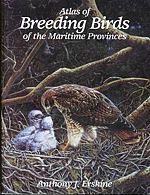 As significant results emerge from the analysis of five years of Maritimes Breeding Bird Atlas (MBBA) data, efforts have now shifted to communicating Atlas results to support conservation action. With funding from Environment Canada’s Habitat Stewardship Program (HSP) for Species at Risk, communications products are being developed for stakeholders whose land-based activities may impact species at risk habitat in the Maritimes.
As significant results emerge from the analysis of five years of Maritimes Breeding Bird Atlas (MBBA) data, efforts have now shifted to communicating Atlas results to support conservation action. With funding from Environment Canada’s Habitat Stewardship Program (HSP) for Species at Risk, communications products are being developed for stakeholders whose land-based activities may impact species at risk habitat in the Maritimes.
The MBBA database contains the most comprehensive and up-to-date information on Maritimes birds, particularly those recently listed as Endangered, Threatened, or of Special Concern by the Committee on the Status of Endangered Wildlife in Canada (COSEWIC), such as Olive-sided Flycatcher, Rusty Blackbird, Canada Warbler, Common Nighthawk, Whip-poor-will, and Bobolink.
Distribution, and abundance maps for several declining bird species illustrate important changes in population and distribution since the first Maritimes Atlas was published in 1992. Stakeholders, including industry, municipal and rural planning commissions, as well as land trusts and nature conservancies, will now have evidence-based information to help plan their conservation strategies for species at risk habitat.
During fieldwork, Atlas volunteers focused on collecting detailed habitat information for all rare birds. The data are now being used to develop Maritimes-specific descriptions of habitats used by recently listed species. These will help with the identification and protection of critical habitat for bird species at risk, and the recovery of their populations in New Brunswick, Prince Edward Island, and Nova Scotia.
For more information on the MBBA, to order a copy, and/or if you are a stakeholder interested in Atlas data, please see the Maritimes Breeding Bird Atlas webpage.
Source: Bird Studies Canada


